
Street style is a dynamic and ever-changing aspect of the fashion world, reflecting the cultural, social, and political shifts of each decade. This decade-by-decade exploration provides insights into how street style has evolved, influencing mainstream fashion and becoming a powerful form of self-expression.
1950s: The Birth of Casual Cool
The 1950s marked the beginning of street style as a recognizable phenomenon. Post-war optimism influenced fashion, and casualwear gained popularity. The iconic James Dean popularized denim jeans and leather jackets, epitomizing rebellious cool. Teddy boys in the UK embraced tailored suits with a rebellious edge, setting the stage for diverse street styles.
1960s: Youthquake and Counterculture
The 1960s witnessed a youth revolution, challenging traditional norms. The mod subculture embraced clean lines and bold patterns, while the hippie movement celebrated free-spirited, bohemian styles. Bell-bottoms, tie-dye, and psychedelic prints dominated the streets, reflecting a shift towards individualism and nonconformity.
1970s: Disco Fever and Punk Rebellion
The disco era brought glam and extravagance to street style. Glitter, platform shoes, and bold colors defined the dance floor. Simultaneously, punk emerged as a rebellious movement, introducing ripped clothing, leather, and DIY aesthetics. The clash of disco glamour and punk rebellion created a diverse fashion landscape.
1980s: Power Dressing and Streetwear Emergence.jpg)
The 1980s were marked by power dressing, characterized by bold silhouettes and shoulder pads. Meanwhile, streetwear began to emerge, influenced by hip-hop culture. Sneakers, tracksuits, and oversized accessories became staples of street style, challenging traditional notions of high fashion.
1990s: Grunge and Minimalism
The 1990s embraced a dichotomy of styles. Grunge, with its flannel shirts and combat boots, represented a rejection of mainstream ideals. On the other hand, minimalism gained traction, marked by clean lines and neutral colors. The rise of streetwear continued, with brands like Nike and Adidas gaining prominence.
2000s: Streetwear Goes Mainstream
The 2000s saw the mainstreaming of streetwear, thanks to influencers like Pharrell Williams and Kanye West. Sneaker culture flourished, and brands like Supreme and BAPE gained cult status. Street style became a global phenomenon, with fashion weeks showcasing a fusion of high fashion and urban influences.
2010s: Social Media and Influencer Culture
The rise of social media platforms like Instagram transformed street style into a global conversation. Influencers and fashion bloggers became trendsetters, blurring the lines between high fashion and streetwear. Diversity and inclusivity took center stage, with street style becoming a celebration of individuality.
2020s: Sustainable and Tech-Infused Styles
As we enter the 2020s, sustainability and technology are shaping street style. Influencers promote thrift shopping and sustainable fashion choices. Tech-infused clothing, such as smart textiles and wearables, adds a futuristic dimension to street style. The emphasis is on conscious consumption and expressing personal values through clothing.
In conclusion, the evolution of street style reflects the ever-changing landscape of society and individual expression. From the rebellious styles of the 1950s to the tech-infused sustainability of the 2020s, street style continues to push boundaries and redefine fashion norms.

